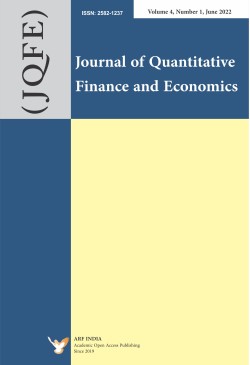
Journal of Quantitative Finance and Economics
Frequency :Bi-Annual
ISSN :2582-1237
Peer Reviewed Journal
Journal of Quantitative Finance and Economics: is an international refereed journal emphasizing on quality, tests of theories, policy implications, and clarity. This journal publishes all areas of Finance and Economics its related fields. All submissions on theoretical and empirical research are welcome.
The Journal accepts submissions throughout the year, for two issues, to be published in June and December. Submissions will undergo a double-blind review process. Initial submissions will be reviewed by the Editor-in-Chief, with a response on desk rejection or desk acceptance to be provided within 1 week. If desk accepted, the Editor-in-Chief will send the article for review, with every effort being made to respond to the author(s) in a timely fashion.
INSTRUCTION TO AUTHORS
Papers must be in English.
Papers for publication should be send in duplicate to the Editor-in-Chief.
Submission of a paper will be held to imply that it contains original unpublished work and is not being submitted for publication elsewhere. The Journal does not accept responsibility for damage or loss of papers submitted. Submitted manuscripts that exceed 25 pages cannot be considered.
Submission of a paper accompanied with a disk is encouraged. The paper file should be in MS-WORD or PDF format. Manuscripts should be double spaced, with wide margins, and printed on one side of the paper only. All pages should be numbered consecutively. Titles and subtitles should be kept as short as possible. References, tables, and figures should be printed on separate pages.
The first page of the manuscript should contain the following information:
(1) the title,
(2) the name(s) and institutional affiliation(s) of the author(s), A footnote should also provide information on the name, address, telephone number, fax number, and E-mail address of the corresponding author.
(3) Abstract: The abstract should be a total of about 200 words maximum. The abstract should be a single paragraph and should follow the style of structured abstracts, but without headings: 1) Background: Place the question addressed in a broad context and highlight the purpose of the study; 2) Methods: Describe briefly the main methods or treatments applied. Include any relevant preregistration numbers, and species and strains of any animals used; 3) Results: Summarize the article's main findings; and 4) Conclusion: Indicate the main conclusions or interpretations. The abstract should be an objective representation of the article: it must not contain results which are not presented and substantiated in the main text and should not exaggerate the main conclusions.
Keywords: Three to ten pertinent keywords need to be added after the abstract. We recommend that the keywords are specific to the article, yet reasonably common within the subject discipline and three-five JEL classification codes.
Formulae should be numbered consecutively throughout the manuscript as (1), (2), … against the right-hand margin of the page. If the derivation of the formulae has been abbreviated, the full derivation should be presented on an Appendix.
References should appear in the text as Smith (1992) or Smith et al. (1998). The author should make sure that there is a strict one-to-one correspondence between the names and the years in the text and those on the reference list. The reference list should appear at the end of the main text, before tables and figures. It should be listed in alphabetical order by author’s name. References should appear as follows:
For monographs: Hansen, J. D., 2001. European Integration: An Economic Perspective. Oxford: Oxford University Press.
For contributions to collective works: Laursen, F., 1995. ‘On studying European integration theory and political economy’, in F. Laursen (ed.),
The Political Economy of European Integration, European Institute of Public Administration, Kluwer Law International, Maastricht. For periodicals: Wyplosz, C., 1997. ‘EMU: why and how it might happen’, Journal of Economic Perspectives, 4, 3-22.
Journal titles should not be abbreviated.
Tables should be numbered consecutively in the text in Arabic numerals and printed on separate pages. The author(s) should point where the table should be inserted in the text.
Figures (illustrations) should not be inserted in the text, and should be marked on the back with figure number and appropriate explanatory legends, and/or sources, and/or notes. They should be numbered in Arabic numerals and consecutively. The author(s) should point where the figure should be inserted in the text.
Articles published in this journal are classified by the Journal of Economic Literature (JEL) the journal also classified by Cabell’s Directory Publications.